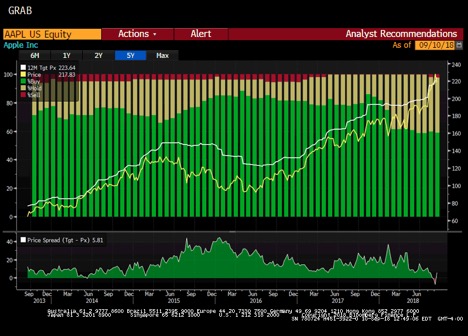Apple is in the news again this week because of its Gathering Round conference where the company announces new products and upgrades. With every event like this comes a new round of price targets and buy/hold/sell recommendations from Wall Street analysts. Our question is why do they bother? Individual price targets are notoriously unreliable and can be dangerously wrong.
All eyes on Apple
Thirty-two firms publish estimates on Apple. Some are boutique analysts, but others are powerhouses like Goldman Sachs.
When Apple was trading around $185 earlier this year, Goldman set a target of $165. They saw earnings issues ahead and translated that concern into an expected price drop. But that drop didn’t happen. Instead of falling, Apple continued to steam forward to its current level in the $220 range. Goldman has now adjusted its price target to $240.
Obviously, a forecast of minus 10% is a pretty big miss when actual performance has been plus 20%. And let’s be clear, Goldman is far from the only firm to miss by a mile on a forecast. It happens routinely at every analyst firm, large and small, and has for decades.
Do faulty forecasts matter?
An investor who trusted and followed Goldman’s guidance on AAPL this year would have sold low and bought back in at a higher price, the worst possible outcome.
Given the frequency of missed forecasts, we have to ask why they still exist. Pension funds and large institutions that monitor dozens of analysts may get some usable guidance by averaging all the forecasts together, but individual investors who try to leverage targets into profits aren’t likely to do very well. Choosing the wrong forecast to follow can be very costly, but you won’t know it’s wrong until the damage is done.
If you can’t trust the forecasting of a firm like Goldman Sachs with its best and brightest staff of analysts and economists, what’s an investor to do? The first part of the answer is simple – ignore price targets completely.
Making a decision to own a stock like Apple is based on each investor’s personal timeline, expectations, financial needs, personal balance sheet and ability to stay focused on the long game. We sort through these considerations in detail for clients before any investment.
Bloomberg on Apple
This Bloomberg chart summarizes analyst forecasts for Apple over the last five years. The yellow line tracks the stock’s actual price. The white tracks an average of where the 32 analysts expect the price to go in the next 12 months. Revisions up or down on the white line occur on or after the price of AAPL changes. Price targets make interesting headlines because they are satisfyingly specific, but they are not good leading indicators.

Graduating from price targets
The investment news cycle doesn’t focus on price target for funds, like Vanguard’s VGT. Right now Apple and Microsoft are the two largest components of VGT, which tracks the IT sector. New securities like Visa and Mastercard have been added in the last ten years. Cisco, Intel and IBM have been long time components. The asset class as a whole is the focus of VGT, not each individual security’s price target.
XLK from State Street uses a different methodology but the tech emphasis is the same. XLK has old timers like AT&T and newcomers like Alphabet and Facebook. Both XLK and VGT have provided generous returns over the last decade, without the guidance of analyst price targets.
What does this mean for me?
A price target is one of many pieces of market information that we feel misleads investors far more often than it educates. We’re here to help sort through the wide variety of information and, with our experience, filter out the remaining information that is most valuable to you and your investment goals.
Weekly Articles by Osbon Capital Management:
"*" indicates required fields
